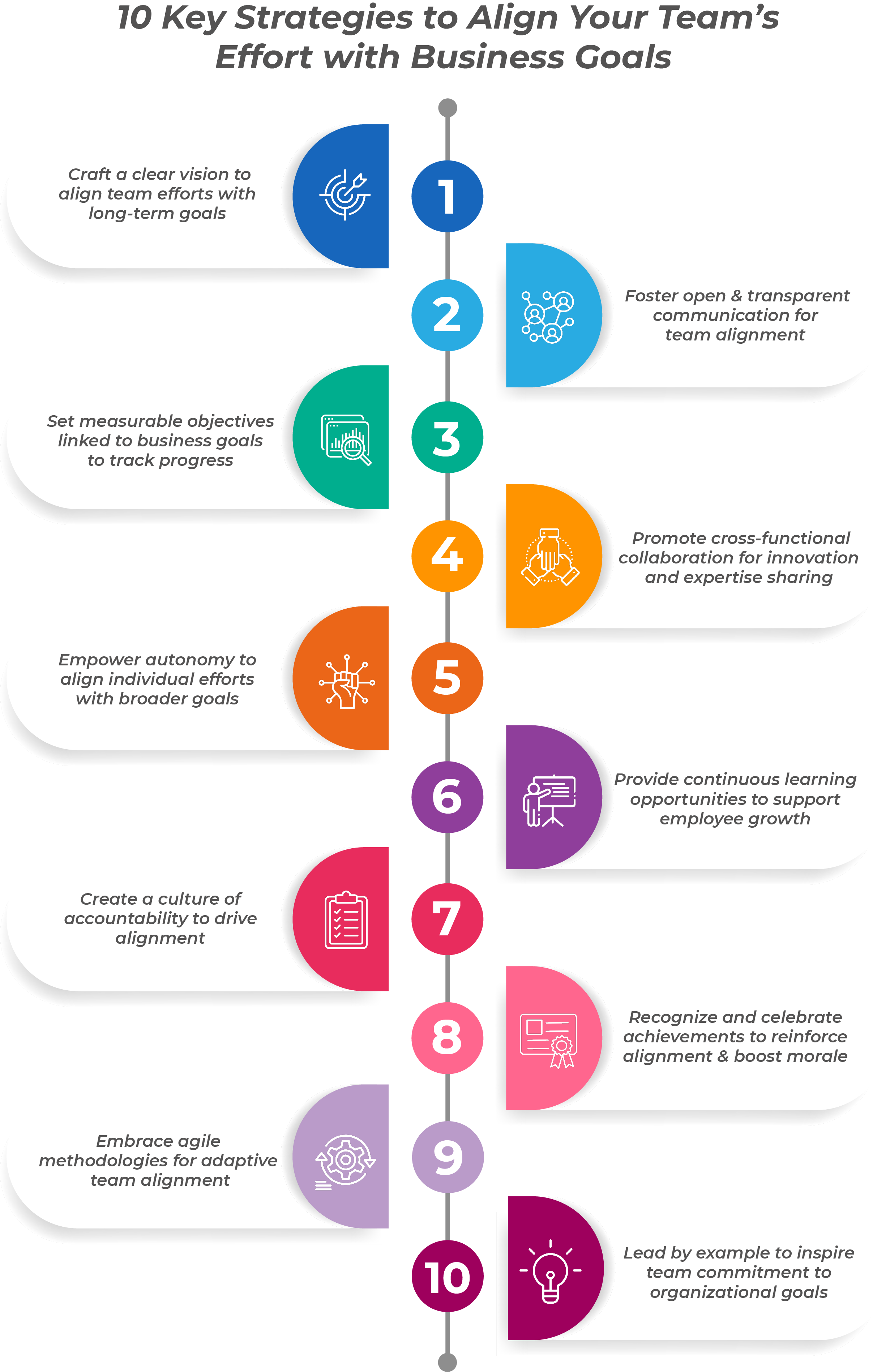In the fast-paced world of software, synchronizing your team with business goals is the ultimate key to achieve successful project outcomes. Whether you oversee a small team or manage a department of significant size, it is nearly impossible for your organization to grow and thrive if your team members are not working cohesively towards a common goal. Teamwork that hits the mark doesn’t just deliver top-notch software within deadlines and budgets, but also sparks a vibrant atmosphere of collaboration and innovation. According to a study conducted by Gallup,
Organizations with highly aligned teams experience 21% higher profitability compared to those with low alignment.
This highlights the impact of team alignment on the financial success of software companies. In this article, we will unlock the importance of team alignment in the software industry and the game-changing strategies to synchronize your team with your business goals and aspirations.
The Role of Team Alignment in Software Companies
1.Shared Vision and Goals
Team alignment ensures that all members of an organization are working towards a common vision and shared goals. When everyone understands and embraces the organization’s mission, they can align their efforts accordingly. This alignment creates a sense of purpose, motivates employees, and fosters a collaborative work environment.
2.Improved Communication and Collaboration
Team alignment facilitates effective communication and collaboration among team members. When individuals are aligned with each other, they can share ideas, knowledge, and feedback more efficiently. This synergy helps in avoiding misunderstandings, reducing conflicts, and increasing overall productivity.
3. Efficient Resource Allocation
Aligning teams with the business direction enables efficient resource allocation. By understanding the organization’s strategic objectives, teams can prioritize their tasks and allocate resources effectively. This alignment prevents wastage of time and effort on non-essential activities, optimizing the utilization of resources.
4.Enhanced Decision-Making
When teams are aligned with the business direction, decision-making becomes more streamlined and efficient. Aligned teams have a clear understanding of the organization’s goals and can make decisions that align with those objectives. This alignment reduces delays, improves agility, and enables teams to respond effectively to market changes and customer demands.
10 Key Strategies to Align Your Team’s Effort with Business Goals
If you’re looking to foster alignment within your team, we’ve got you covered with these 10 powerful strategies that will help you lead the way:
1.Establish a Clear Vision
Craft a compelling vision that clearly articulates the organization’s long-term goals. When team members understand the bigger picture, they can align their efforts, accordingly, channeling their energy towards achieving the desired outcomes.
2.Communicate Effectively
Effective communication is the cornerstone of team alignment. Foster an open and transparent environment where information flows freely among team members. Regularly share updates, provide feedback, and encourage two-way communication to ensure everyone stays on the same page.
3.Define Measurable Objectives
Set clear and measurable objectives that align with the organization’s overall business goals. By establishing key performance indicators (KPIs) and milestones, team members can track their progress and understand how their contributions directly impact the success of the project.
4.Foster Cross-Functional Collaboration
Break down silos and promote collaboration across different departments and teams. Encourage cross-functional projects, knowledge sharing, and interdisciplinary brainstorming sessions to leverage diverse expertise and drive innovation.
5.Empower Autonomy
Empower team members by giving them autonomy over their work. Provide guidelines and support, but also trust them to make decisions and take ownership of their tasks. When individuals feel empowered, they are more likely to align their efforts with broader business goals.
6.Provide Continuous Learning Opportunities
Invest in the growth and development of your team members. Offer training programs, workshops, and mentorship opportunities to enhance their skills and expand their knowledge. When employees feel valued and supported, they are more motivated to align their efforts with organizational goals.
7.Foster a Culture of Accountability
Create a culture where accountability is valued and rewarded. Encourage team members to take responsibility for their actions and outcomes. By setting clear expectations and holding individuals accountable, you foster a sense of ownership and drive alignment with business goals.
8.Recognize and Celebrate Achievements
Acknowledge and celebrate individual and team achievements. Publicly recognize the efforts and contributions of team members who align their work with the overall business goals. Celebrations and rewards create a positive feedback loop that reinforces alignment and boosts morale.
9.Embrace Agile Methodologies
Implement agile methodologies, such as Scrum or Kanban, to promote iterative development, collaboration, and adaptability. These methodologies emphasize regular feedback, continuous improvement, and a flexible approach to aligning team efforts with changing business needs.
10.Lead by Example
As a leader, embody the values and behaviors you expect from your team. Lead by example, demonstrating alignment with the organization’s goals through your actions and decisions. Your team will follow suit, inspired by your commitment and dedication.
Conclusion:
In the ever-evolving world of software, aligning your tech team’s work with overall business goals is not just a choice, but a necessity for success. The impact of team alignment on the financial prosperity of software companies cannot be ignored, with highly aligned teams experiencing a remarkable 21% increase in profitability, according to Gallup.
By embracing the strategies discussed in this article, you can foster a culture of collaboration, innovation, and purpose within your team. From establishing a clear vision to leading by example, each strategy plays a vital role in ensuring that every team member is working cohesively towards the organization’s goals and objectives. Remember, when your tech team is aligned, there are no limits to what you can achieve in the realm of software development. So, unlock the potential of team alignment and watch your projects soar to new heights of success.


